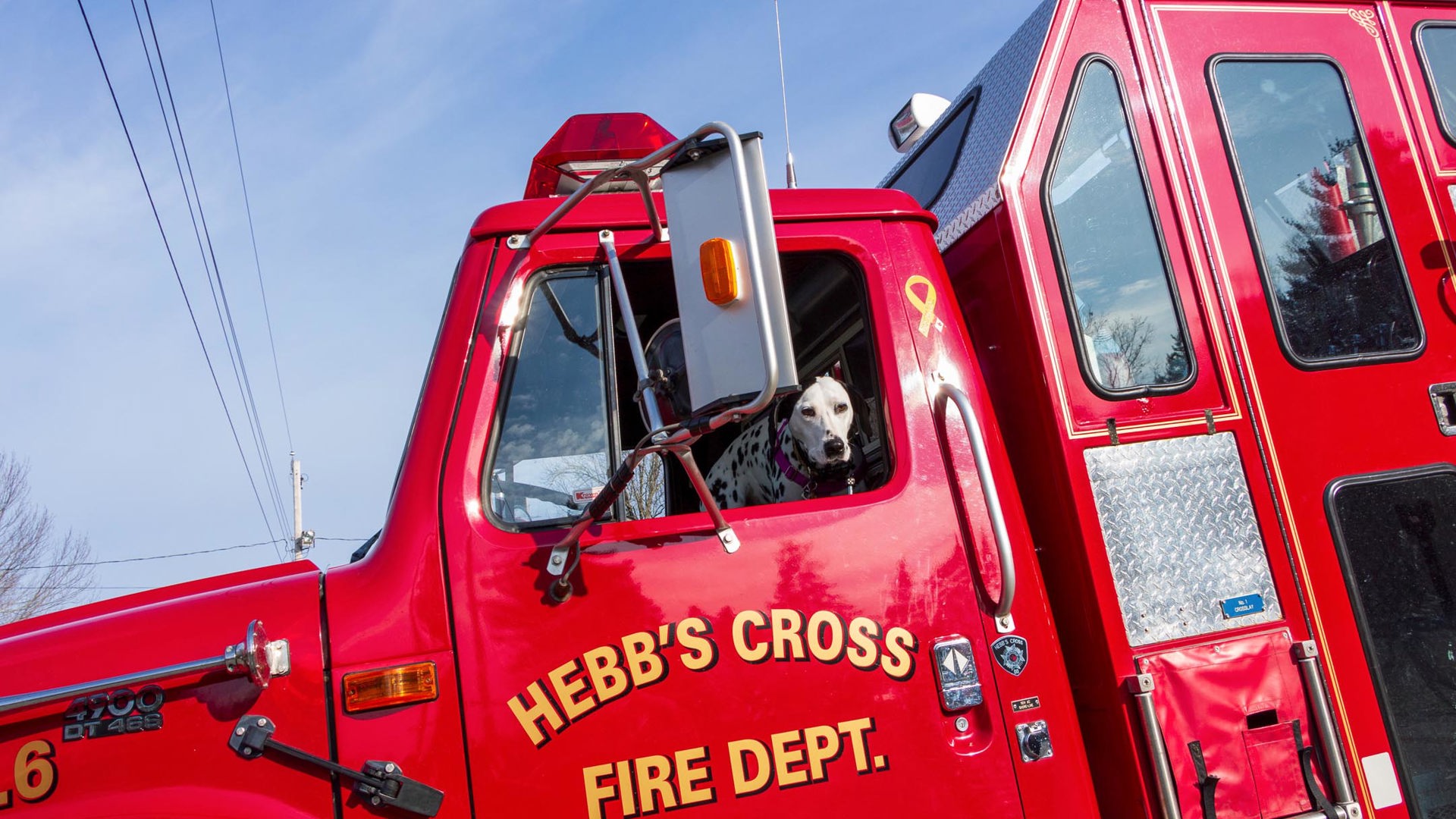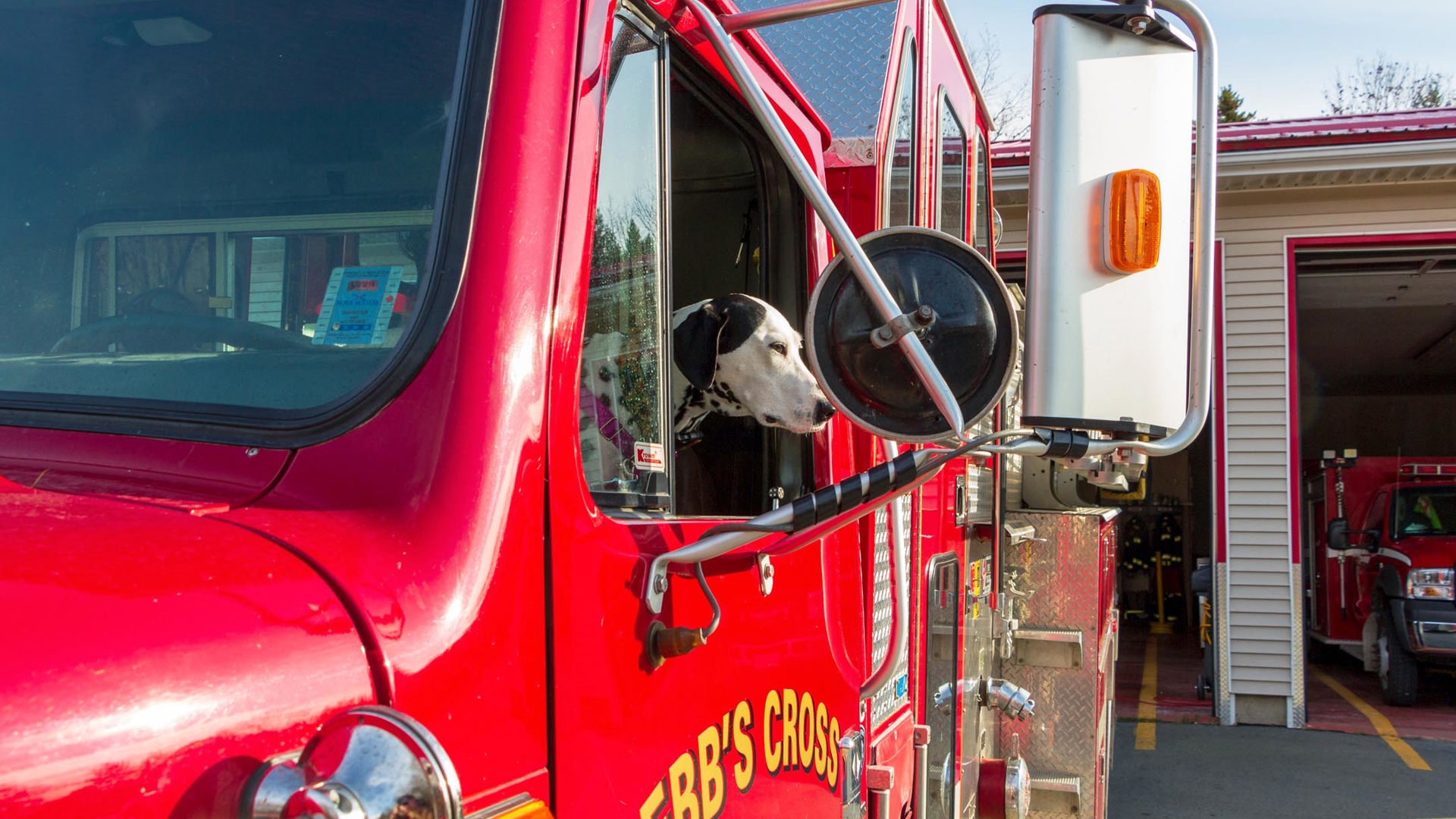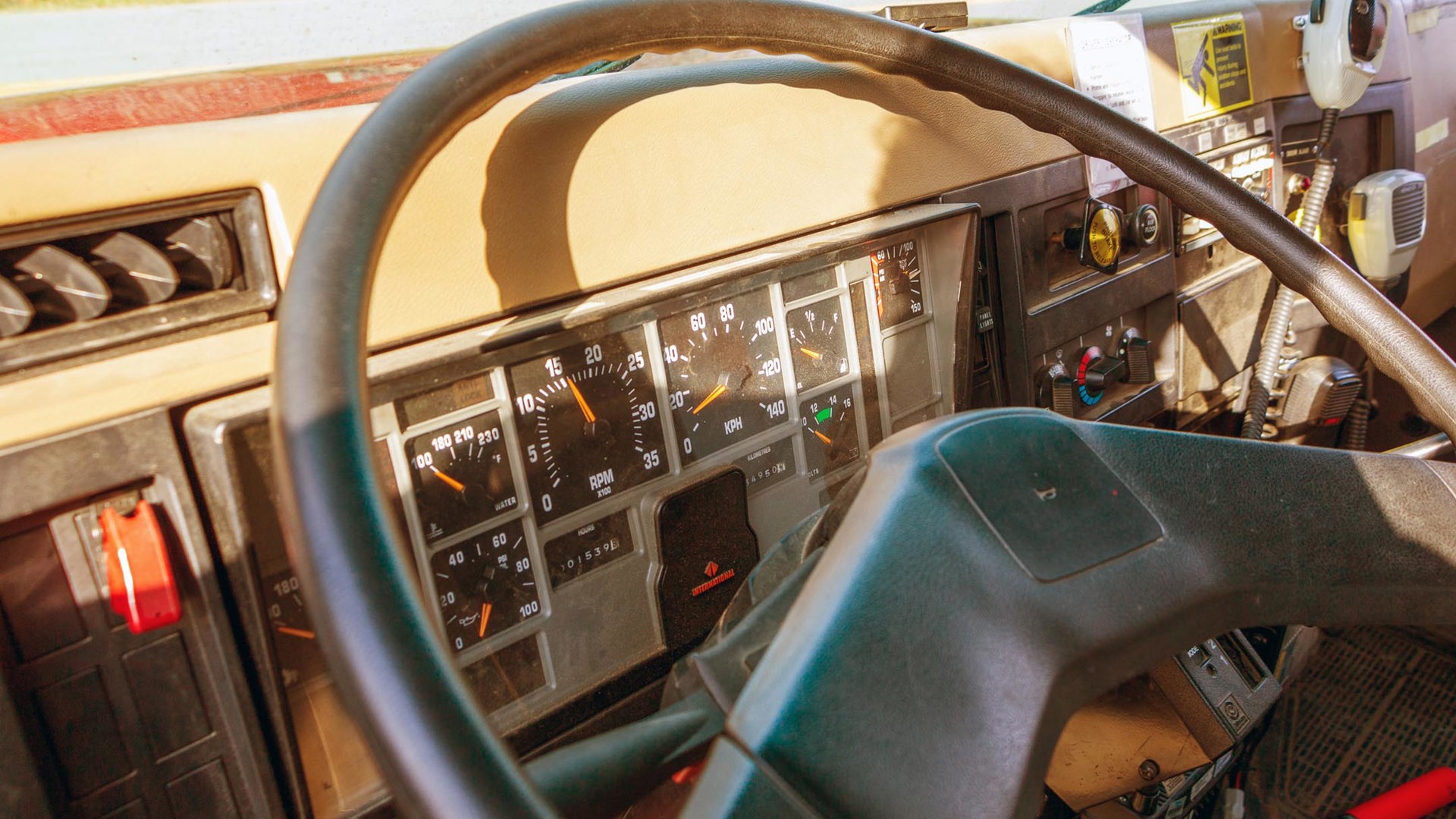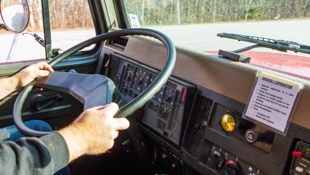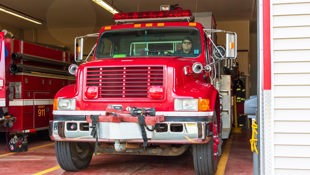 AutoTrader SCORE
AutoTrader SCORE
-
STYLING9/10
-
Safety3/10
-
PRACTICALITY10/10
-
USER-FRIENDLINESS5/10
-
FEATURES4/10
-
POWER3/10
-
COMFORT1/10
-
DRIVING FEEL10/10
-
FUEL ECONOMY3/10
-
VALUE10/10
It’s the vehicle that nearly every five-year-old wants to drive but few will ever get to. For many of us, that desire never quite fades away, a distant siren call that’s rekindled at every, well, siren.
It’s the largest vehicle we’ve ever reviewed for AutoTrader.ca, and just about the most expensive: a Fort Garry Fire Trucks Pumper Truck, built on a 1994 International chassis. To help make sure the test is as thorough as possible, we’ve brought our own fire dog and expert rear-window tester, Morgan.
Styling: 9/10
If you want attention, there’s no better way to grab it than with this. Sure, the lines are almost entirely straight from the cab doors back, and the hood itself was used on just about every International medium-duty truck made for several decades – but just look at it: a red paint so bright that it’s named for the truck that wears it, accented by a white stripe and hand-painted pinstriping around the truck’s multiple compartments, chrome and engine-turned aluminum trim gleaming in the sun.
It’s a touch dated, but for a 1994 model, we’d say it’s worn quite well. The wheels are painted to match the bodywork, and the trim under the cab gets a black-paint look that’s become so popular that these days Toyota’s applying it to its Sienna minivan. At the back, though, the whole thing gets a bit untidy thanks to taillights that look like they’re out of the Princess Auto trailer catalogue, hoses and rope dangling from the upper racks, and a mess of accessories that provide for easy access but are less than easy on the eyes.
Practicality: 10/10
It’s hard to find a more versatile vehicle than the pumper truck. This one offers loads of places to store your items, including no fewer than 12 locking cabinets with exterior access. They’re used to hold gear ranging from tools to axes, first aid equipment, extrication tools, and any dozens of things that the crew of this truck needs to save lives every day. Ram Box saddlebags and the Honda Ridgeline’s under-bed trunk have nothing on this big red brute.
Ladder racks on each side hold 40-foot extension ladders but hide an impressive feature: the racks, assisted by struts, pivot down to bring the ladder down instead of requiring firefighters to reach up and lift it over their heads – a back- and time-saver you won’t find on your average truck.
On the top is enough storage to hold hundreds of feet of hose as well as a portable water storage tank. The pumper apparatus (the proper name for the truck, we’re told, is “fire apparatus”) is the most common type of truck because it works as a jack of all trades. It can pump water from the portable tank or its internal tank – or from a hydrant or lake – pulling the water through the hose toward the fire, allowing firefighters to combat the flames.
The truck’s internal tank can hold 4,100 L of water – about enough to fill a Chevrolet Suburban’s interior – and the pump can drain it (or fill it, useful for this rural truck) in well under a minute at full go. A hose and reel on the front bumper complement the side-mounted 2.5- and 4.5-inch pump outlets to dispense the water.
Behind the cab, which has plenty of width for up to three fully equipped firefighters, there is a second, smaller cab with room for several more. While this increases passenger space, it doesn’t seem to have climate control, so there is a comfort trade-off. If you’re looking for grocery space, however, the second cab should more than suffice.
Safety: 3/10
We’re torn on the safety category here. On the one hand, this truck is loaded with extraction tools, first-aid gear, and first responders who are trained to save your life. It also has a siren that could wake the dead, enough flashing lights to start a rave once COVID restrictions ease, and an air horn that nearly gave me a heart attack when I pulled on the cord mistaking it for a hand-hold when trying to climb in (take a point off for user-friendliness).
On the other hand, forget about active safety features like pedestrian detection or lane guidance, this truck doesn’t have a driver airbag or ABS! Not even a shoulder belt. To be fair, this particular vehicle can legally flaunt most rules governing right of way and direction of travel – no need for lane-departure warnings. And no computer technology can match the excellent post-crash response system on-board.
Features: 4/10
No Android Auto or Apple CarPlay since the smartphone wasn’t even imaginable back in 1994, but the lack of a simple AM/FM cassette deck disappoints. It does have a trio of two-way radios that deliver traffic and situation updates in near real time, essential for this type of vehicle. Crank windows, manual locks, and no A/C are likewise checkmarks in the negatives column.
All that is made up for, however, by the panel that holds the switches for the lights and sirens. Those little goodies provide far more entertainment and richer sound than your mobile device. The lights and sirens are intended to be a traffic-avoidance feature, prompting other vehicles to yield their lane to you, but they don’t work as well as planned, taking another point from the score. As far as fire apparatus features goes, this one doesn’t have the automatic tire chains used on more modern trucks, hurting performance in winter.
User Friendliness: 5/10
The ladder racks are a big hand for loading and unloading cargo, as are the steps leading up to the top of the tank. Inside, massive controls for the HVAC system and the large gold push-button for the air-brake system all allow you to operate this truck even with fire-resistant gloves on. Ingress is helped slightly by the chrome side-mounted handle, but it’s still two large steps up to a narrow doorway. With no interior handles, getting in and out in a respectable fashion is nearly impossible, something my photo assistant captured in a series of shots that will not make this gallery.
A near-flat steering wheel requiring more hand movements than I could count to go lock-to-lock makes this one tough beast to manoeuvre in tight spaces, something that’s not helped at all by the long wheelbase and nearly-as-long rear overhangs. An automatic transmission is a plus, but you need to remember that it doesn’t have a “Park” position before you hop out at a scene.
Power: 3/10
Under the big red hood is a Navistar DT 466, an inline-six diesel that’s powered medium-duty trucks since 1971. 7.6L means, in this case, somewhere around 275 hp for the turbocharged and intercooled engine and 800 lb-ft of torque. A big torque figure for sure, but with just five gears in the Allison automatic and the weight of all of that sheet steel and aluminum, tools, and four tonnes of water, this moves along about as quickly as a later VW bus. It tops out at about the same, too, not able to get much past 90 km/h.
Despite being an inline-six, known as one of the smoothest of all commonly used layouts, this engine makes as much racket as the sirens. A mechanical fan, belt-driven air compressor, and injectors the size of my head all work together with the barely contained explosions of individual diesel-powered pistons each displacing as much air as an entire Chevrolet Trailblazer’s engine to create a sound that requires hearing protection in the cab and frightened our fire dog from outside of it (she also hates the loud “pfft” of an air brake in operation).
Comfort: 1/10
If you’re comfortable in here, you’re probably doing something wrong. Beyond the sound of the engine, driveline, and siren, if you’re driving this you’re probably already too stressed by what’s coming or what you’ve just left to be comfortable. It’s not helped by the XL-pizza-sized wheel, bench seat, coil springs, or water shifting behind you. It’s loud, everything bangs around, and it sounds like it’s about to fall apart at any moment. The velour quilted fabric, hand-tooled with firefighter-themed logos, is extremely cool, however, and helps make this interior feel special.
Fuel Economy: 3/10
Wait, you’re serious? It is a diesel, but vehicles this big don’t get official fuel consumption ratings. Online estimates suggest anywhere from 20 to 35 L/100 km, depending on your foot and the amount of water in the back. We’d expect closer to the latter. Fortunately, the fuel tank is big too.
Driving Feel: 10/10
You will probably feel amazing while driving this rig, especially with all of the lights flashing, siren blowing, and the windows open. As long as you’re not headed to a fire, that is.
Subjectively it is the best thing I’ve driven since a Nissan 370 snowmobile but objectively it’s a different story. Extremely grabby brakes thanks to the air braking system, nearly no suspension, a turning circle measured in football fields, and more understeer than a fleet of summer-tired crossovers in the snow all make this drive feel like a workout more than a Sunday drive.
The looks and waves you get from other cars make you feel like a million bucks, though, mostly making up for your discomfort.
Value: 11/10
A truck like this, new, runs about half a million including all of the gear required to get it ready to go into service. While that seems expensive, it’s a highly specialised piece of equipment built nearly entirely by hand. It’s also required to last at least 20 years of service in all sorts of weather and abuse.
This particular truck served for decades at a city department before being sold to a much more rural department, increasing the value proposition for taxpayers at both ends of the equation. Of course, if it is your fire or accident to which the truck is responding, that price likely suddenly seems like quite the bargain.
The Verdict
How was it? Exactly as amazing as your five-year-old self had dreamed all this time. It’s not the best truck in the world, it’s probably not even the best truck in this station, at least as far as comfort and performance go, but it ticks all of the boxes for doing exactly what it needs to do every day to help save lives during fires, motor vehicle crashes, and responding to medical calls.
It’s big, it’s red, it’s crude, and it’s effective; everything it needs to be and everything you hoped it was.
Special thanks to the Hebbs Cross Volunteer Fire Department for facilitating this test in support of the NS Firefighters 50/50 https://www2.rafflebox.ca/raffle/nsfd/36
| Engine Displacement | 7.6L |
|---|---|
| Engine Cylinders | I6 |
| Peak Horsepower | 275 hp @ 2,000 rpm est. |
| Peak Torque | 800 lb-ft @ 1,300 rpm est. |
| Fuel Economy | 20–35 L/100 km cty/hwy est. |
| Cargo Space | 4,100 L (of water) |
| Model Tested | 1994 International 4900 Series w/Fort Garry Fire Trucks Custom Pumper Body |
| Base Price | |
| A/C Tax | |
| Destination Fee | |
| Price as Tested | $250,000 est. |

